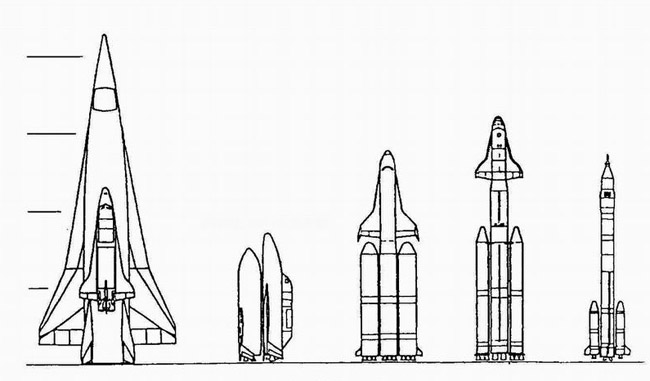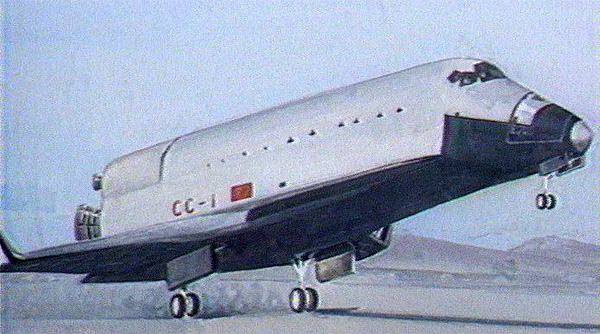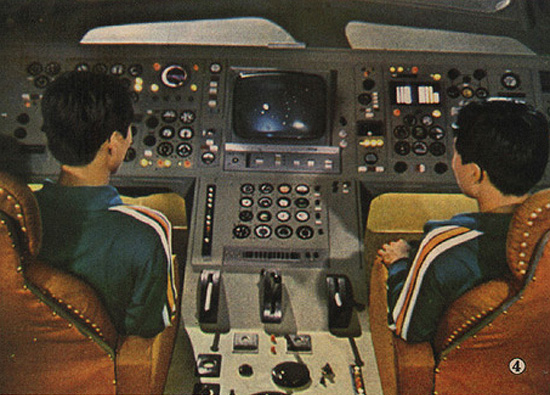| PROJECT 921-I (MANNED SPACECRAFT)
中国航天921-I计划(有人操纵太空船) Date:2016-01-08 Source:internet By:Globalmil Viewed: |
Following China’s unsuccessful attempt of manned spaceflight in the 1970s, the manned space programme resurfaced in the late 1980s under Project 863, a long-term initiative to transform China’s science and technology in fields such as space research, material science and genetic engineering. Concept studies were conducted on a number of projects, including a Russian-style ballistic capsule manned spacecraft and a more ambitious reusable space shuttle, both of which aimed to put first Chinese astronaut in space by 2000.
中国在1970年有人操纵宇宙飞行不成功的尝试之后,有人操纵空间计划在1980年后期的863计划下再度浮现,长期主动去转换中国科技例如在空间研究、材料科学和遗传基因工程学。概念研究在许多的计划上被实施,包括一个俄国-风格弹道太空舱有人操纵太空船和一个更雄心勃勃的可再重复使用航天飞机,两者在2000年之前打算首先将中国太空人送入空间。

在早期阶段中国有人操纵空间计划一些设计方案。(从左边到右边)(1)601航空器研究所的H-1空间航空器。航空器使用级联涡轮喷射发动机从常规飞机场实现起飞和降落;(2)北京第11空间研究院V-2火箭。航空器两者都有二级火箭发动机为基础;(3)第八空间研究院设计的长城-1(ChangCheng-1)航天飞机,使用独立的推进系统用于太空运载工具;(4)第一个空间研究设计的TianJiao-1航天飞机。这是美国太空运载工具的缩小型而且与欧洲的赫姆斯航天飞机提议类似;(5)CZ-2 E运载火箭和弹道太空舱被第五空间研究院设计的有人操纵太空船提议。
Some design proposals in the early stage of the Chinese manned space programme. (From left to right) (1) H-1 Space Aircraft by the 601 Aircraft Institute. The aircraft uses cascaded turbojet engines to achieve the take-off and landing from a normal airport; (2) V-2 rocket aircraft by 11 Space Institute in Beijing. The aircraft has two stages both of which are based on the rocket engines; (3) The ChangCheng-1 (Great Wall-1) space shuttle designed by Eighth Space Academy, with independent propulsion system for the space vehicle; (4) The TianJiao-1 space shuttle designed by the First Space Academy. This is a scaled down version of the U.S. space vehicle and is similar to the European Helms space shuttle proposal; (5) The CZ-2E booster and ballistic capsule manned spacecraft proposal designed by the Fifth Space Academy.
In January 1992, a special meeting was held in Beijing to hear the opinions of China’s top scientists on the possibility of a manned space programme. Different design proposals were also presented during the meeting. It was concluded that such a programme was both possible and necessary to boost the country’s confidence and technological capabilities. The modest proposal of using the existing CZ-2E booster to send a ballistic capsule manned spacecraft into orbit was chosen instead of the more ambitious space shuttle design, which requires much more sophisticated technologies.
在1992年1月,一个专门会议在北京举行去听取中国高层科学家对有人操纵的空间计划可能性的意见。不同的设计提议也在会议期间被呈现。普遍得出结论这样的计划对推进国家信心和科技能力,既是可能的且是必需的。谨慎的提议使用现有的CZ-2E火箭去发射一个弹道太空舱航天器进入轨道内而不是更雄心勃勃的航天飞机设计,后者需要更加复杂的技术。

第八空间研究院(现在宇宙飞行技术上海学院,SAST)的长城-1(ChangCheng-1)航天飞机设计提议。系统是基于现有CZ系列运载火箭和一个可重复使用轨道运载工具,运载工具能依靠它自己的发动机飞行。
The ChangCheng-1 (Great Wall-1) space shuttle design proposal by the Eighth Space Academy (now Shanghai Academy of Spaceflight Technology, SAST). The system Is based on the existing CZ family booster with a reusable orbit vehicle, which cab fly on its own engines.
A special team consisting China’s top aerospace scientists was formed in early 1992 to study the manned space programme. In August 1992, the team delivered its report which described the three steps in developing China’s manned spaceflight technology. The first step aimed to develop a manned spacecraft and its supporting systems, and to put China’s first astronaut in space and then return safely. The second stage was to grasp the space docking technology, which would finally lead to a temporarily man-tended “Space Laboratory”. In the third stage, China would a 20-tonne class permanent space station.
一个专门研究组由中国顶级航空宇宙科学家在1992年组成去研究有人操纵空间计划。在1992年8月,研究组递交了它的描述三个阶段发展中国有人操纵宇宙飞行技术报告。第一个阶段打算发展一艘有人操纵的太空船和它的支援系统,并且把中国第一位宇航员送入空间然后安全地返回;第二个阶段要抓住空间站技术,将最终通向临时有人看守“空间实验室”;在第三阶段中,中国20吨级长期空间站。
On 21 September 1992, the Chinese leadership finally gave the go-ahead for the National Manned Space Programme, codenamed Project 921. The first phase of the project (Project 921-I) was given four main goals: (1) To grasp the manned spaceflight technology; (2) To conduct space observation to the earth other scientific research; (3) To develop a space-earth transportation vehicle; (4) To obtain experience for future permanent space station.
在1992年9月21日,中国领导层最后批准国家有人操纵空间计划,命名为921计划。第一阶段计划(921-I计划)被给予四个主要的目标:(1)掌握有人操纵宇宙飞行技术;(2)引导对地球其它科学研究的空间观测;(3)发展一种空间-地球运载工具;(4)为将来的长期宇宙站获得经验。

中国国家媒体在1980年新闻相片中显示中国宇航员在类似美国航天飞机的模拟驾驶座舱中训练。
News photo by the Chinese state media in the 1980s showing Chinese astronaut trainees in a simulator cockpit similar to the U.S. space shuttle.
The initial target of Project 921-I was to launch two unmanned versions of the spacecraft, followed by the first manned spaceflight in 2002. The programme entered full scale development in 1993. The first Chinese manned spacecraft is a three-module, three-seat design similar to the Russian Soyuz-TM. The major difference is that the orbital module of the Chinese spacecraft is larger and capable of autonomous flight after the conclusion of the mission, while the orbital module of the Soyuz-TM has to be burned out after being separated from the re-entry capsule. Additionally the Project 921 spacecraft can support three astronauts to stay in space for seven days compared to five days service life of the Soyuz-TM.
921-I计划最初目标去发射二艘无人操纵型太空船,在2002年后继进行第一个有人操纵宇宙飞行。计划在1993年进入了全尺寸发展。第一艘中国有人操纵太空船是一种三模块,三座位设计与俄国Soyuz(联盟)-TM类似。主要的差别是中国太空船的轨道模块(轨道舱)更大和能够在任务的结束之后自主飞行,而Soyuz- TM的轨道模块必须在与返回模块(返回舱)分离之后烧毁。另外921计划太空船能支持三名太空人停留达七天之久,相对比Soyuz-TM的空间有效寿命为五天。

(左边)俄国Soyuz-TM太空船和(右边的)中国神舟太空船。它能被看到神舟的轨道模块比Soyuz-TM的更大,它自己用于自主飞行的太阳面板从再返回模块分离。
(Left) Russian Soyuz-TM spacecraft and (Right) Chinese ShenZhou spacecraft. It can be seen that the orbital module of ShenZhou is larger than that of the Soyuz-TM, with its own solar panels for autonomous flight after being separated from the re-entry module.
It was well speculated that the Chinese manned spacecraft design had benefited from the Russian technology and experience, though it is unlikely that China used any parts directly copied from the Soyuz-TM or built under license. In September 1994, Chinese President Jiang Zemin visited Yuri Gagarin Cosmonaut Training Centre in Russia, and a deal was signed in March 1995 for two Chinese military pilots—Wu Jie and Li Qinglong—to train alongside the Russians. Later in 1998 they returned to China and to join a team of 12 astronaut candidates selected from over 800 air force fighter pilots.
一般很好地推测中国有人操纵太空船设计已经从俄国的技术和经验中获益,虽然它不太可能中国从Soyuz-TM采用了任何的零配件直接地仿造或在许可之下制造。在1994年9月,中国江泽民主席访问了俄罗斯尤里·加加林(Yuri Gagarin)宇航员培训中心,而且商定在1995年3月安排二名中国飞行员—李金龙(Wu Jie)和吴杰(Li Qinglong)—在俄国共同训练。在1998年稍后他们回到中国加入12名宇航员候选人,这是从超过800名空军战斗机驾驶员中被挑选的。
Details of Project 921 began to surface in 1998. A sixteen month overhaul of China's YuanWang space tracking fleet was completed in Shanghai in January 1999, with the fourth ship joining the fleet in July. Other associated projects including the building of the Beijing Space Command and Control Centre and a brand new launch site at Jiuquan Space Launch Centre, as well as the development of the CZ-2F space launch vehicle were all nearly completed. In mid 1999 an Internet source photo revealed a CZ-2F launch vehicle carrying the first unmanned spacecraft prototype was ready for launch at Jiuquan.
921计划的细节在1998年开始浮出水面。一个历经十六个月的中国“远望”(YuanWang)空间跟踪船队大修1999年1月在上海完成,同时第四艘船在七月参加船队。其它关联研究包括建造北京空间指挥与控制中心和一个在酒泉(Jiuquan)空间发射中心新的发射位置的标志,并且发展的CZ-2 F空间运载火箭全部接近完成。在1999年中期一张互联网照片显示运载火箭携带一艘无人操纵太空船原型在酒泉准备发射。
On 19 November 1999, the first unmanned prototype of China’s Project 921 spacecraft, named ShenZhou, was launched into space from Jiuquan. The re-entry capsule returned to the scheduled landing site in Inner Mongolia successfully after 14 orbits of the earth in 21 hours and 11 minutes. China launched another three unmanned spacecraft ShenZhou-2, -3, and –4 between January 2001 and December 2002.
在1999年11月19日,中国的921计划的第一个无人操纵太空船原型命名为“神舟”(ShenZhou),从酒泉发射进入空间。返回空间舱在历经21小时11分钟14圈地球轨道飞行之后成功地返回到预定在内蒙古的降落位置。中国发射了另外的三艘无人操纵太空船神舟-2、神舟-3和神舟-4,在2001年1月至2002年12月之间。
The first successful manned flight took place on 15 October 2003, when ShenZhou-5 carrying China’s first astronaut Yang Liwei was successfully launched from Jiuquan Satellite Launch Centre. After travelling 21 hours and 23 minutes on the earth orbit, the spaceship landed in Inner Mongolia safely, making China the first country in more than 30 years to join the United States and Russia in the exclusive club of manned mission launchers.
第一次成功的有人操纵飞行在2003年10月15日发生,当ShenZhou-5运送中国第一位太空人杨利伟(Yang Liwei)成功地从酒泉卫星发射中心发射。在地球轨道上运行21个小时23分钟之后,太空船安全地在内蒙古降落,在超过30年后使中国成为参加美国和俄国独占的载人任务发射者俱乐部的第一个国家。
The last launch Project 921-I, ShenZhou-6, was carried out between 11 and 17 October 2005. The spacecraft carrying two astronauts Commander Fei Junlong and Operator Nie Haisheng circled around the earth for 76 times in five days. For the first time the astronauts were able to take off their heavy spacesuits and enter the orbital module to carry our scientific experiments. The astronauts returned to the earth safely in the early morning on 17 October. The ShenZhou-6 mission was described as a perfect finale for Project 921-I, as well as a solid basis on which the second phase of China’s manned space programme Project 921-II can be carried out.
921-I最后发射计划,神舟-6,被在2005年10月11日至17日进行。太空船运送二名宇航员指挥官费俊龙(Fei Junlong)和操作员聂海胜(Nie Haisheng)在五天中围绕地球运转76圈。第一次宇航员能够离开他们沉重的太空服并且进入轨道模块(轨道舱)进行科学实验。宇航员在10月17日早晨安全地返回到地球。神舟-6任务描述为921-I计划的一个完整的结局,并且第二个阶段的中国有人操纵空间计划921-II计划能够在一个坚实的基础之上进行。
上一篇:没有了 下一篇:PROJECT 921-II (SPACE WALK, SPACE DOCKING, AND SPACE LAB)
| TianGong 1 Spaceflight Mission
中国天宫(TianGong) 1航天任务 |
| As the first step, China will launch TianGong 1, also known as “target spacecraft”... [2020-12-08] |
| CHANG'E MOON EXPLORATION PROGRAMME
中国航天月球探险计划 |
| The Chinese government first announced that it was planning to carry out moon exploration and preliminary deep space research in its White Paper on China’s Space Activities published on 11 November 2000.... [2016-01-08] |
| SHENZHOU-1/2/3/4 UNMANNED SPACEFLIGHT MISSION
中国“神舟”-1/2/3/4无人操纵航天飞行任务 |
| Between November 1999 and December 2002, China launched four unmanned experimental spaceships to test the launch vehicle, spaceship, and life support systems onboard.... [2016-01-08] |
| PROJECT 921-III (SPACE STATION)
中国航天921-III计划(空间站) |
| In the third stage of the Chinese manned spaceflight programme, which is known as Project 921-III, China is going to build a permanent space station where astronauts can live for a long period (few months) and conduct various scientific expe... [2016-01-08] |
